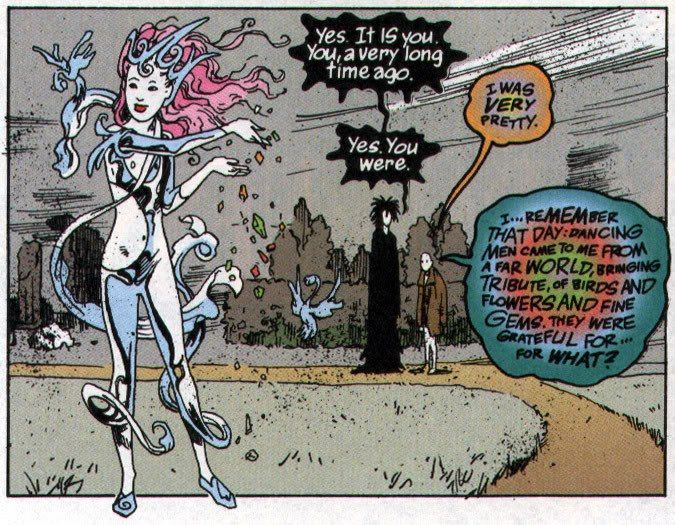It looks like you're using an Ad Blocker.
Please white-list or disable AboveTopSecret.com in your ad-blocking tool.
Thank you.
Some features of ATS will be disabled while you continue to use an ad-blocker.
Guess a Germanic form of early Judaism was the last thing they wanted, but that's probably what you get if you believe freemasons. It's interesting how there's been three High Gods, Ouranos, Saturn, and Jupiter, wonder if that's related to precession somehow or the advancement of the human race, as order increases. Rome perhaps an example of a positive Jovian influence, Baal/Yahweh more negative.
What will Aquarius will bring in terms of Gods? Further back Goddesses reigned supreme, the demonisation of Goddesses an obvious huge blunder that will naturally be righted, as inevitable as the tide.
The Egyptian Saturn was “Horus, Bull of Heaven,” and his falcon head was often shown topped with a set of bull's horns. He guided the dead to the underworld, where his father Osiris ruled.
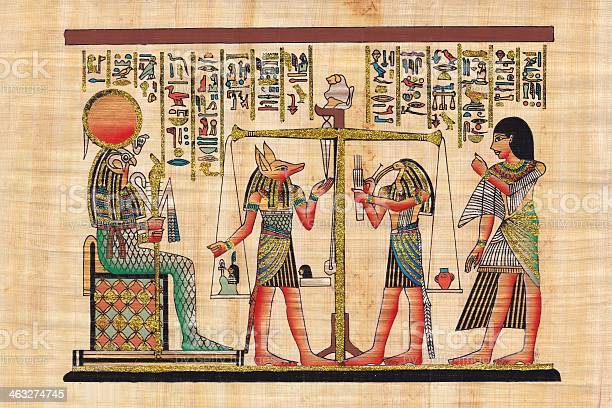
there is also a “black sun” featured in ancient Egyptian texts and iconography, with multiple meanings. In the tomb of Irunefer at Deir el-Medina, the deceased is shown to be illuminated by the sun, shadows who want to harm him are captured in the Netherworld, and “the darkness” in the form of a black sun aborbs all the evil which is arrayed against the deceased, thus the black sun here functions as almost a kind a sin-eater. The papyrus of Ani made for his burial depicts supernatural villains threatening the deceased and being covered with the darkness of a shining black sun, which is meant to refer to a place for the sinful dead; it seems that Christianity was not the only religion to believe in a place of punishment after death. Similar to the context of the sun god Utu, the black sun appears in connection to judgement in the Netherworld, and in monuments it appears as a devourer of the sin and evil of the damned souls, thus protecting the cosmic order and the beatified dead.

An incarnation of the pharaoh in the Pyramid Texts, in the Book of Two Ways the “Lord of Power” is one of the “judges” threatening the deceased. Viewed from different perspectives (e.g., inhabitants of the Netherworld, the pharaoh, the noble deceased, the sungod), the Black Ram and related characters of the later sources seem to be dangerous and hostile creatures not as much “by nature” but by context and situation in which the solar energy exists in a particular moment and to whom it is opposed. More generally, this essay shows that characters often perceived as demonic genetically can possess positive divine, even solar, energy, which in some contexts can receive dangerous, aggressive manifestations.
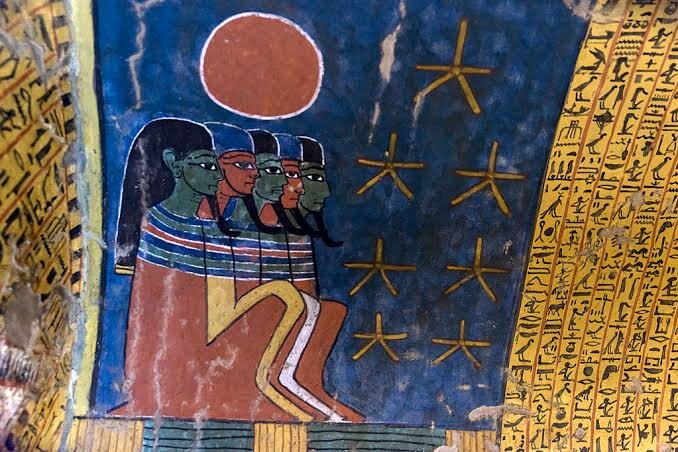
I'd guess the Nazis also made a mistake with the SS totenkopf death cult symbolism, likewise a problem with Judeo-Christians, that sort of things not built to last. Inanna's star would be a better option, the moon, eagle's, swans, and bears obviously have a long tradition, as does the sun cross itself.
Yes i wonder why En-ki never gets to be High God, maybe it's because he is very easy going and just likes drinking beer and having sex and making a million varieties of Beetles as a hobby and wants nothing to do with morals, they should at least let him during the Age of Aquarius.
Horus was the planetary God of all the planets, he wanted the seven Divine powers to himself, but Urrsa Major was the Bull (thigh) in Egypt and that's why the Magical spells can't make their mind up between Bulls and Bears, you can see it on that Mistress of Beasts pictures you posted.
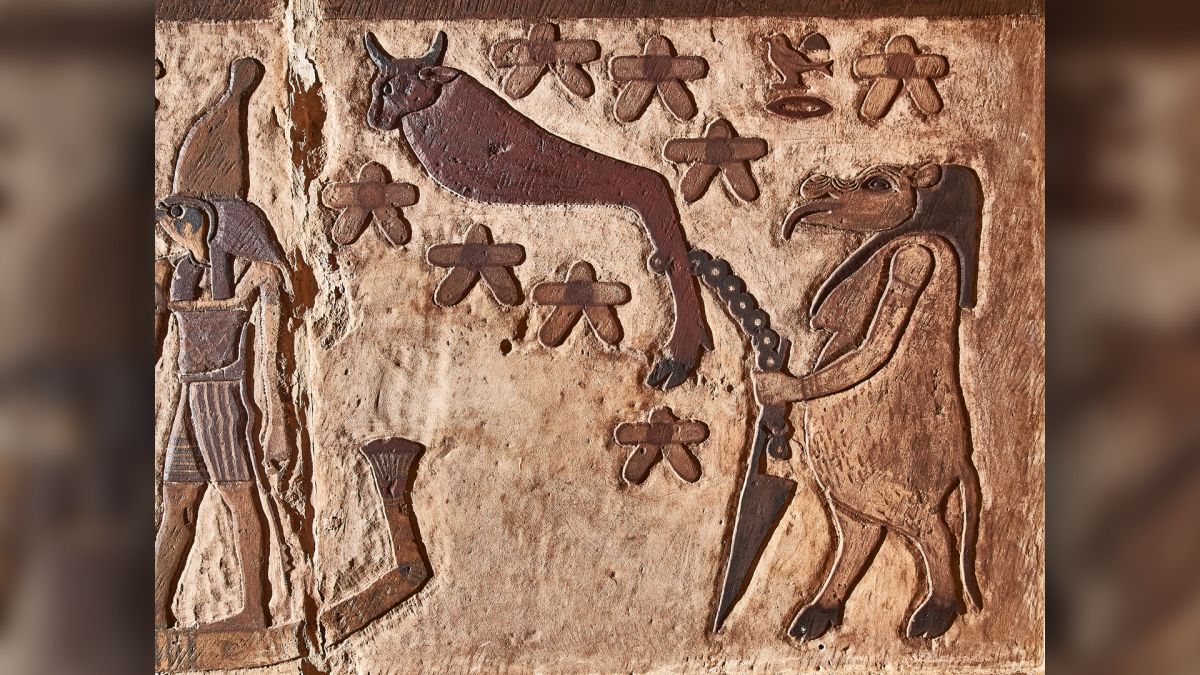
Egyptologists argue all the time over this sort of thing, such as what does the figure with the raised arm spearing the Bull represent and they never agree and are always wrong.
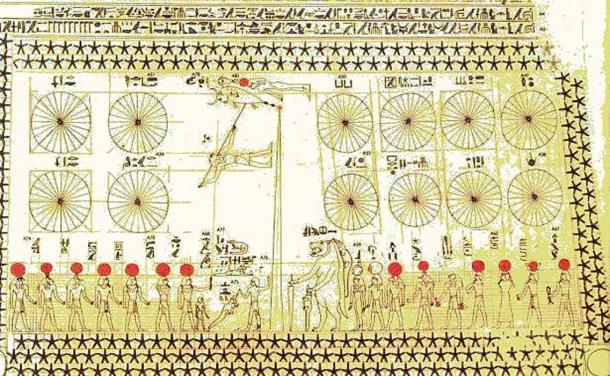
As an exercise if one simply looks at the stars circa 2,500 BC were Thuban as the Pole star is highlighted with Ursa Major beneath, can you see the figure with the raised arm, because if you can that is more than Egyptologist can see, they don't know which constellation the figure represents.
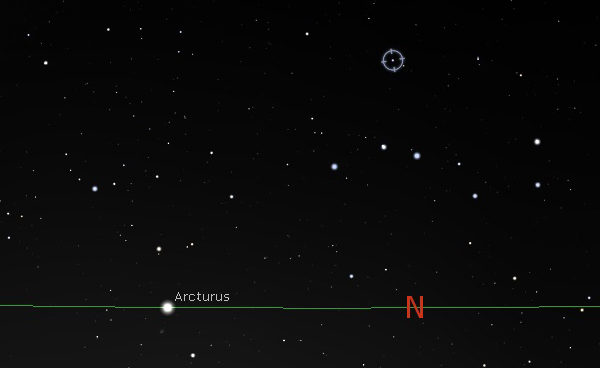
a reply to: AstroStar
Because they're setting with the Sun that's their period of maximum invisibility, so there literally would be nothing to see, but Sah and Sopdet of the Northern skies would have been visible during the night.
Ursa Minor, the latter would more closely relate to seven actual heroes from the mythology, but then you would have to match these up with the seven spiritual qualities or auras as related to En-lil.
Had a bit of a look at doing this, no idea if it's accurate, but it was fun anyway.

First comes melammu - fearsome radiance, aura, awesomeness. Melam breaks down to vital force, will to life, desire, opportunity, fire, hot, to set fire.
So basically divine radiance as seen in angels halos, or the Buddhist rainbow body auras, also jewels, crowns, and various forms of Divine splendid garments.
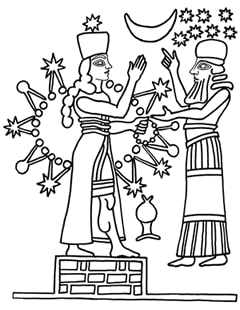
Gilgamesh conned Humbaba out of his 7 Divine Powers, actually one of the things he swapped was his sister, so no wonder Enlil took them back and distributed them elsewhere, bit of a lowlife really, at least at the start.
He gave Humbaba's first aura to the fields.
He gave his second aura to the rivers.
He gave his third aura to the reed-beds.
He gave his fourth aura to the lions.
He gave his fifth aura to the palace. [one text has debt slaves]
He gave his sixth aura to the forests. [one text has the hills]
He gave his seventh aura to Nungal.
There's also this description of Enlils powers, which are elemental in nature.
Without the Great Mountain Enlil . . . the carp would not . . . come straight up[?] from the sea, they would not dart about. The sea would not produce all its heavy treasure, no freshwater fish would lay eggs in the reedbeds, no bird of the sky would build nests in the spacious lands; in the sky, the thick clouds would not open their mouths; on the fields, dappled grain would not fill the arable lands, vegetation would not grow lushly on the plain; in the gardens, the spreading trees of the mountain would not yield fruit.
By using the etymologies of the Sages names and their descriptions its possible to get some broad categories for each.
Uanna- “who finished the plans for heaven and earth”, “u” means “earth, world, totality,” and “anna” means “approval, consent, or word of consent.” - Elemental powers of Earth, forests, mountains.
Uannedugga- “who was endowed with comprehensive intelligence, “u = crew of a ship, or a ship’s cabin” and “an” = “sky,” with “ne” equal to “strength, force,” and “dug” meaning “to speak, talk, say, order, negotiate,” and “ga” meaning “house.”
- Elemental powers of the Sky
Enmedugga- “who was allotted a good fate”, “en” = “lord, master, ruler”, “me” = “battle, combat, being”, “duga” = “command.” - Must be the lion.
Enmegalamma - “who was born in a house“, En” means “lord, master, ruler,” with
“me” equal to “divine properties enabling cosmic activities,” and “galam” equal to “skillful, clever, to make artfully,” and “ma” being “ship, boat, siege engine.” - Elemental powers of water, apsu, rivers.
Enmebulugga, “who grew up on pasture land”, “en” = “lord, master, ruler”
“me” = “battle, combat, being”
“bulug” = “foster child, novice, to grow up”
“ga” = “suckling” - Elemental powers of Earth, fields, grain.
An-Enlilda - “the conjurer of the city of Eridu”, “an” = “sky, heaven”, “en” = “lord, master, ruler”, “lil” = “secret knowledge”
“da” = “writing board” and “da” = “to mix, stir into a liquid” - This guys a straight up sky wizard, perhaps sky as in quintessence.
Utuabzu - “who ascended to heaven”, “uttu” = “count, number”, “abzu” = “cosmic underground water.” - The art of being salty.
Yes there's some pretty dodgy etymology there and the Sumerians themselves were sketchy when it came to the auras and sages, En-lil's redistribution seems a little wonky, might be better understanding through the post-Vedic.
In post-Vedic texts, different lists appear; some of these rishis were recognized as the 'mind-born sons' of Brahma, the representation of the Supreme Being as Creator
The relationship to Brahma can be taken as per En-lil and Northern Sah in Egypt, the Astral Deity represented by Bootes
In ancient Indian astronomy, the asterism of the Big Dipper (part of the constellation of Ursa Major) is called saptarishi, with the seven stars representing seven rishis, namely "Vashistha", "Marichi", "Pulastya", "Pulaha", "Atri", "Angiras" and "Kratu". There is another star slightly visible within it, known as "Arundhati". Arundhati and Vashishtha are married, and together form the Mizar double
The fact the seven auras should correlate to the Planets can be seen in the inclusion of the elusive eighth star which would then represent Earth among the planetary archetypes and represented by Alcor and the elusive Fox, post-Vedic tradition has a very positive opinion of Alcor, it may be the case that Erra was Mizar and his companion who he dallies with Mamu the Goddess of dreams, the sister of Sig-sig, the Fox star tag indicating the two combined, a Goddess Niggina is identical to the abstract noun nig-gi-na "truth" ,she is considered to be Utu's principal daughter, Niggina's sister is Mamu, and her brother is Sisig.'
Arundhati is the wife of the sage Vasishtha, one of the seven sages (Saptarshi) who are identified with the Ursa Major. She is identified with the morning star and also with the star Alcor which forms a double star with Mizar (identified as Vasishtha Maharshi) in Ursa Major. Arundhati, though the wife of one of the seven seers, is accorded the same status as the seven seers and is worshipped with them as such
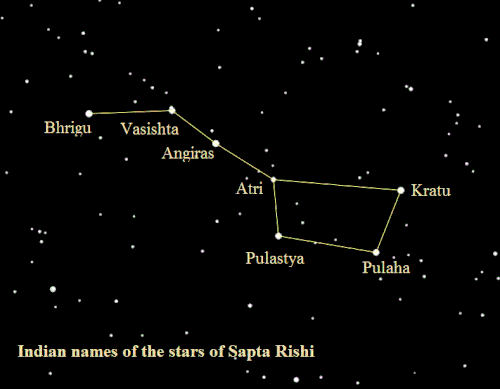
That would also correlate the faint star Alcor of Ursa Major to Elektra and the lost dream of Atlantis, and dreams in general as the Goddess of such.
Electra, although for at least two or three centuries the title of a clearly visible star, has been regarded as the Lost Pleiad , from the legend that she withdrew her light in sorrow at witnessing the destruction of Ilium, which was founded by her son Dardanos
Hyginus wrote, Electra left her place to be present at its fall, thence wandering off as a hair-star, or comet; or, reduced in brilliancy, settled down close to Mizar (in Ursa Major) as Alopex, the Fox, Ovid (43 B.C.-18?A.D.) called her Atlantis, personifying the family.
The Pirt-Kopan-noot tribe of Australia have a legend of a Lost Pleiad, making this the queen of the other six, beloved by their heavenly Crow, our Canopus, and who, carried away by him, never returned to her home.
The importance of Mizar is based in it being used to align to true North in conjunction with Kochab of Ursa Minor.
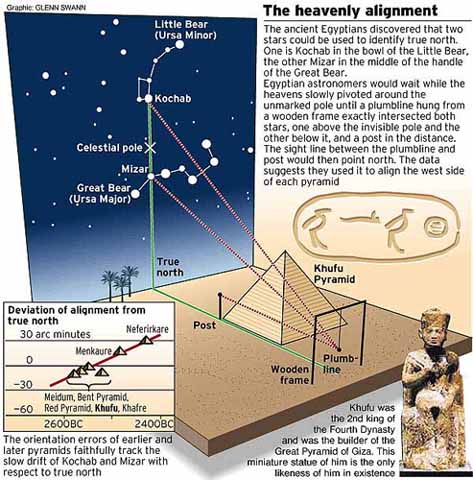
Thus it is the Apron star of Free Masonry as the first principle in aligning a construction to Celestial North.
Mizar derives from the Arabic miʼzar meaning 'apron; wrapper, covering, cover'. Alcor was originally Arabic Suhā/Sohā, meaning either the ‘forgotten’ or ‘neglected’ one; notable as a faintly perceptible companion of Mizar
Yea thought it might be junk, shouldn’t have used the etymology from Ashtar Command haha, knew the seven auras represented the planets, so it was more a logic fail than anything.
The Vedas list numerous siddhis, the tradition provides countless examples of them being used in the past, but modern exponents of such warn not to use them, not ‘spiritually correct’, a pretty good excuse to not demonstrate powers that they don't have really, not the sort of thing found at kundalini workshops.
Interesting about Alcor, Earth, and the fox, a very successful predator, where most have struggled in modern times the fox thrived, even found in urban environments... favored of Urash then.
As one of the brightest stars in the sky, Arcturus has been significant to observers since antiquity.
In ancient Mesopotamia, it was linked to the god Enlil, and also known as Shudun, "yoke", or SHU-PA of unknown derivation in the Three Stars Each Babylonian star catalogues and later MUL.APIN around 1100 BC.
The traditional name Arcturus is derived from the Ancient Greek Ἀρκτοῦρος (Arktouros) and means "Guardian of the Bear", ultimately from ἄρκτος (arktos), "bear" and οὖρος (ouros), "watcher, guardian". The name has been used since at least the time of Hesiod, circa 700 BC.
Arcturus was the medieval spelling of Aurthur, in an old version of the tale he gets taken up to Bootes where he dwells eternal in the crystal palace Arcturus. Ireland too has lots of mythological Arts and Math’s... more bear names.
Up to the riche sterri briht dongoun
Astronomeers weel reherse kunne
Callid Arthuris constellacioun…
Wher he sit crowned in the heunly mansioun
Amyd the paleis of stonis cristallyne nyne
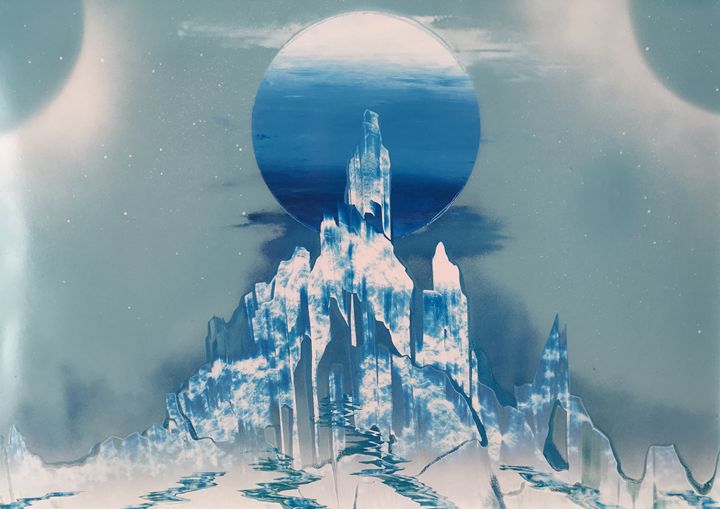
I like the idea of the Fox for Mizar and Alcor because of the Mesolithic hunting origins, the Anatolian Deities Iyarri and Inara providing the later basis for Apollo and Artemis, Inara may have found her way to Japan.
Inari's foxes, or kitsune, are pure white and act as their messengers. According to myth, Inari, as a goddess, was said to have come to Japan at the time of its creation amidst a harsh famine that struck the land. "She [Inari] descended from Heaven riding on a white fox, and in her hand she carried sheaves of cereal or grain.
Inari's female aspect is often identified or conflated with Dakiniten, a Buddhist deity who is a Japanese transformation of the Indian dakini, or with Benzaiten of the Seven Lucky Gods. Dakiniten is portrayed as a female or androgynous bodhisattva riding a flying white fox.
The other important aspect is the translation of the qualities of the Sun to these in terms of the son of the Sun and the daughter of the sun, fox-fire which usually manifests as fire, electricity and/or light, Elektra as the Greek word for Amber, it was this that was the basis for the flaming torch of Erra, the light in the darkness of the night watchman, these qualities are being associated with Saturn and stars of Ursa Major as the Astral correlation.
The classical names for amber, Latin electrum and Ancient Greek ἤλεκτρον (ēlektron), are connected to a term ἠλέκτωρ (ēlektōr) meaning "beaming Sun". According to myth, when Phaëton son of Helios (the Sun) was killed, his mourning sisters became poplar trees, and their tears became elektron, amber
In Middle Low German, amber was known as börnstēn (with etymological roots related to "burn" and to "stone". The Low German term became dominant also in High German by the 18th century, thus modern German Bernstein
If we take the seven auras as having the qualities of the seven Heavenly bodies one of those in Mesopotamian tradition would have been the Sun and one also the Moon as well as the Five planets, so it can be taken that the quality of the Sun would be expected to translate to one of the seven stars and that determines the role of Erra/Sig-sig/Hendursanja as the guardians of the night, they were the proto-type for the electric lamp-post.
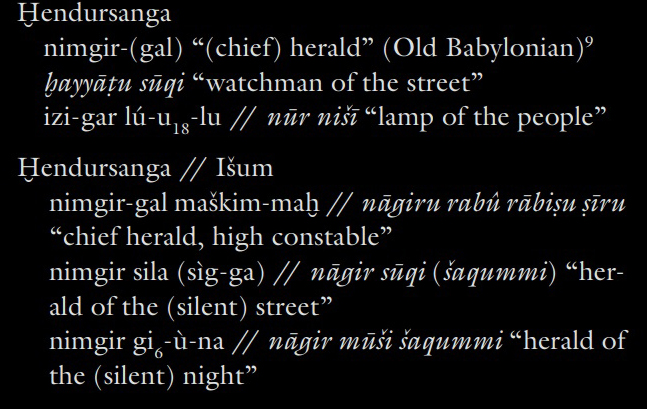
Earlier in the poem of Erra and Išum, Erra’s heart explicitly identifies Išum as diparu, “a firebrand,” that the gods follow into battle . From this it follows that the light which the night watchmen Išum and Ḫendursanga shone to lead people home at night was a burning torch or firebrand. Indeed, it seems likely that Išum’s divine power was instantiated in the fiery glow of the torch, and that his name was indeed the masculine form of the Akkadian common noun išātum, “fire.
Ninlil bore Išum for Šamaš, then set (him alight) and left him in the street.”
Street Lighting in Babylonia
Anyway given Ninlil's association with Ursa Major it's notable she's the one responsible for causing the effect, Bootes as En-lil the consort of Ninlil was the Astral Deity Sah of the Northern skies in early Dynastic Egypt, later also Orion of the Southern skies and the basis of the Divine Kingship because early Dynastic Royal seals show Bootes rising prone on the Eastern horizon and upright on the Western having translated through 90 degrees, with the toe star Arcturus planted upon the horizon.

Pretty amazing the way you work out the meaning of all those tablets and seals.
Hendursanga as the night-watchman seems to have taken an active role in calming some of Erra's more destructive impulses, and also in helping him root out evil, lighting the way for Erra and the Sebittu. When the Gods wanted something broken, looks like this was the crew they called on.

The Sebittu were seven warriors Gods said to be the the sons of Anu and Urash.
The Seven gods are “champions without peer”, and have been called “personified weapons”. They are each assigned a destructive destiny by Anu. They are in differing traditions of good and evil influence.
The oldest definate reference to the Sebittu is in Gilgamesh where Utu, the Sun God, commands them help Gilgamesh on the way to the cedar forest. Pathfinders, they know the route to the forest, which is somewhat liminal in nature.
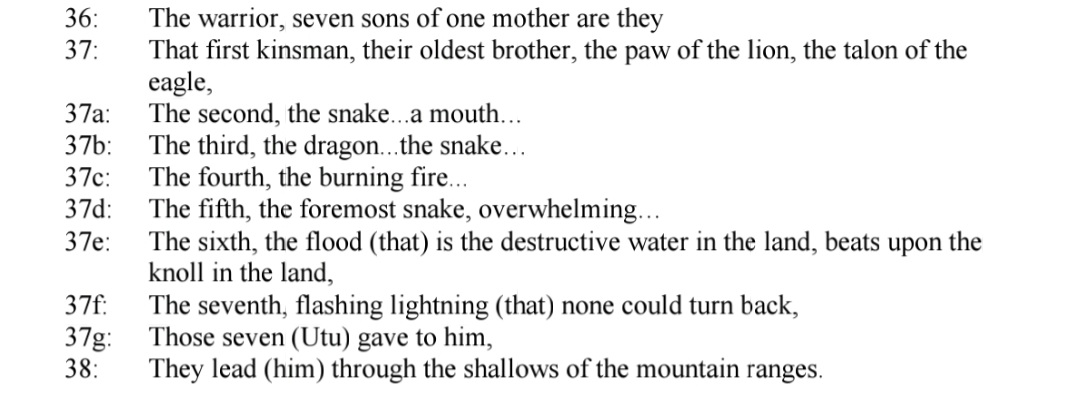
They are sometimes treated as demonic, but still in the context of working for the Gods. Certainly a chaotic and destructive bunch, they have both cthonic and astral references, as stars they are connected to the Pleiades.
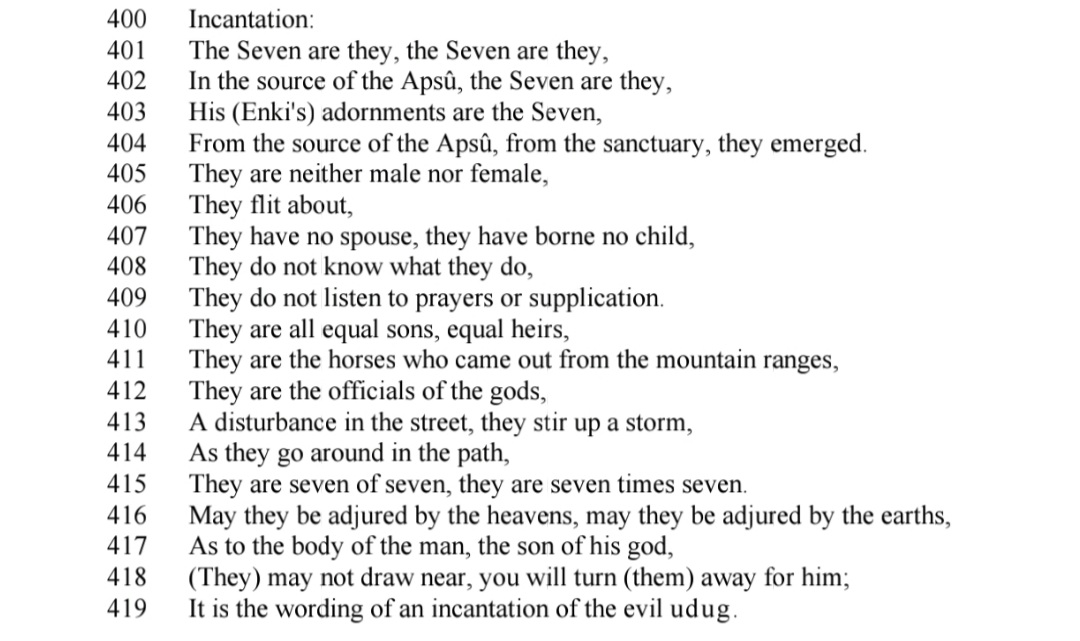
Under the control of Erra and Isum, they'd be good for helping deal with the Cabal problem plaguing the planet atm.
It's because i cheat as i already know the answers to the test like seeing Alcor, there's a funny story on this were seven Abbeys in France are laid out in the pattern of Ursa Major and you have to find the Alcor Stone, but this is just like the seven churches of Asia Minor in the Book of Revelations.
"LA COMTESSE DE CAGLIOSTRO", LUPIN discovered the secret of Alcor:
A.L.C.O.R
"Ad Lapidem Currebat Olim Regina"
"The Queen ("Reine") ran towards the stone in the past."
The secret of Calor is that of the Philosopher's Stone
C.A.L.O.R.
Currebat Ad Lapidem Olim Rhedae*
Run towards the stone of the Rennes of the past.
Of course all the gold treasure is buried beneath the Alcor stone but in what sense, what is the treasure of a King of France except his Queen of Beauty, as usual they just end up looking for the bones of Mary Magdalene, but this is like looking down empty Fox holes, though they do equate Alcor with the Rose Line and alignment to Celestial North, which is the tradition.
All this story of all this treasure hidden in a block of stone, in full view of everyone who comes near it, is in all conscience strange enough. But it’s nothing, Josine, nothing at all compared with the idea which dominates the story. You cannot imagine how strange it is—and how beautiful! What poetry and what simplicity!”
The problem with countering the Cabal with the seven stars is that's the basis of their religion in terms of the seven branched Menorah, it's a variation of the same theme but i think in the negative aspect of seven stars of Antares, there was much confusion between those of Ursa Major and the Demonic destructive aspects of the Scorpion, but the same themes will carry through and so perhaps Alcor translates to the heart of the scorpion Antares.
There is obviously a lot of correspondance also between the Mesopotamian archetypes of the light in the darkness, the star of the silent night, the night watchman and Jesus, the best form of countering is continuity, simply move on and look to the positive as it's a cyclic process and reclaim the greater tradition, though this is also running towards the past.
The test here is spot the Scorpion.
Yes well I suppose spotting the scorpion is a good idea if you don't want to be stung. Had one on my eski not too long ago, it was dark but just saw the movement, put it in a cup and showed the lads then released it back to the bush, I quite like them.
As a principle related to Ishara, the sting would get delivered for oathbreaking, so betrayal, even of yourself perhaps because Ishara means- to bind. She was also a love Goddess and healer, a connection between the underworld Gods and the Heavenly, balancing out the weapon aspect of Scorpio.

Antares is the base of Tree, where life springs forth from the underworld and in this Ishara is the vital link between chaotic formless potential and matter, the Lady of Transmutation, with Alcor again lighting the way ☀️
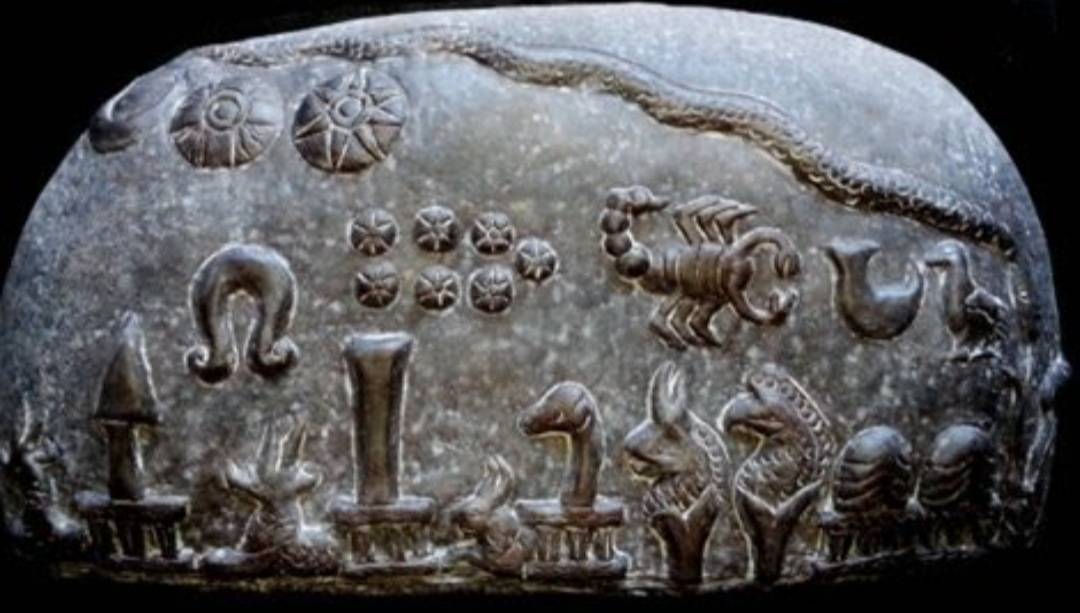
In a different version to the Anu/Urash one, the seven Sebetti were said to be her children. This might be because when the stinger of Scorpio is rising, the Pleiades are setting.
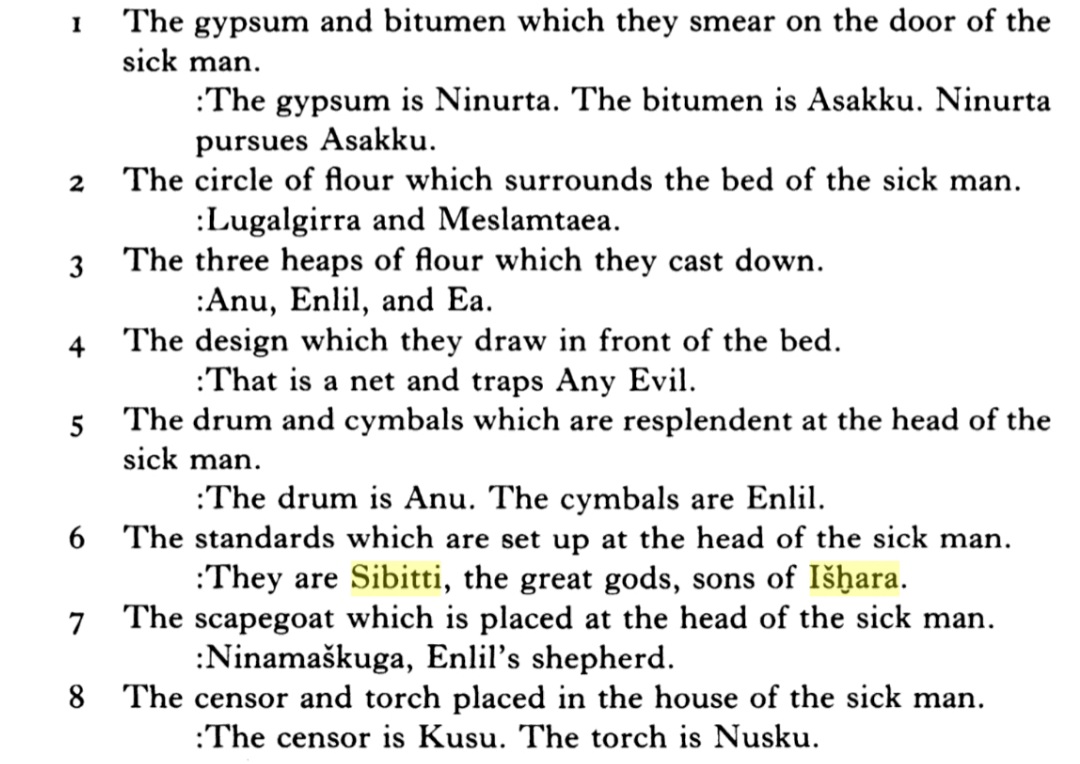
The Hebrew connection was surprising, that would probably come from Elba, where Ishara's cult was founded, and the mob of loan sharks that fled the place on the run from the God Tessub and justice, they found succour with the Habiru bandits, likeminded in moral apathy I guess.
Tessub demands that the city institute a debt remission. He promises that, if the city complies, it will experience great prosperity and military success. If it fails to comply, drastic judgment awaits it. In a similar manner the Judean chronicler attributed the destruction and exile of the Kingdom of Judah to her failure to observe Yahweh's sabbatical year remissions (2 Chronicles 36:17-21; cf. Leviticus 26).
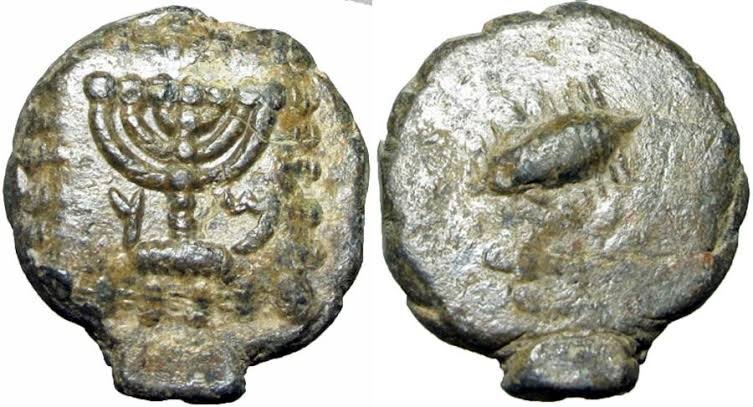
Before the Hebrews did away with most of the female elements of their religion they worshipped Asherah, who was Isahra, as the wife of Yahweh, likely the basis of the Shekinah in the more modern Cabala.
Asherah is a Hebrew word for what was either a goddess or a cultic object or perhaps both.
Invoking the seven Sebetti Gods in negative form with a strange menorah ritual would be a very bad idea as their destruction was on order of the Gods alone. Can't see people having any authority over them whatsoever, and when they were let loose without control they just wrecked things badly, in this case probably just the minds of the summoners, as with all demonic callings, but easy to see how that can manifest into the world via their actions.
Ishara certainly doesn't approve!
The Demonic manifestation is through the Sethian, hence the association of Egyptian Seth with Antares and likely Nephtys, the transformation of the seven auras/planetary archetypes towards the absolute negative, this is purification in terms of being able to withstand Sethian subversion through maintaining positive principles such as oathkeeping, dedication to the Gods and one's people, obviously few are capable of withstanding Sethian corruption particularly politicians, though the common people have generally recognized this evil for what it was.
In principle those who have aligned themselves with Sethian Demonic evil should be eradicated, that is the basis of the test, like you say as Ishara was the principle Goddess of Ebla and Ashera the consort of El in Canaan they should have been more familiar with these principles than anyone as they inherited them from Anatolia and Mesopotamia, but they rejected them and became the personification of evil, there is some attempt at reintroduction through Christianity with the Doctrine of the Holy Spirit but the basis remained esoteric and nothing was properly explained, the muddled implementation intended to encourage Europeans to behave and conform.
It's interesting to note that the cycle begins with the knowledge based initiative of the Sages, the Feminine underlying basis is established through the Pleiades and then the Masculine basis through Ursa Major, which as the most potent and dynamic is the apex of the conceptual system, with the seven Demons of the Scorpion the distinction between Male and Female breaks down, as does all critical thinking and moral boundaries and one finds oneself in the current situation.
Just an attempt to tie together a few correspondences...
Mercury, Venus, Mars, Saturn, Jupiter, Sun, Moon, Earth.
Dubhe, Merak, Phecda, Megrez, Alioth, Alkaid, Mizar, Alcor.
Erra/Mizar/Saturn
Mamu/Alcor/Earth
Anu/Alkaid
Aya/Alioth/Sun
The Wagon, Ninlil (The 7 principal stars of Ursa Major)
The star at the shaft of the Wagon, the Fox, Erra, the strong one among the gods (The star Zeta in Ursa Major)
The star at the front of the Wagon, the Ewe, Aya (Probably the star Epsilon in Ursa Major)
The Hitched Yoke, Anu, the great one of the heavens (the star Eta in Ursa Major)
Figured Aya had to be the Sun, but not sure which planet Anu would represent, possibly Sigsig should be in there too as he's amongst the same group of Gods.
Aya functions primarily as a goddess of light and as the wife of the sun god Šamaš
In Old Babylonian administrative documents from the vicinity of the city of Sippar, Aya appears also to share her husband Šamaš's role in overseeing justice
Aya was associated with morning light and the rising sun. In this role she was called "morning-maker."
Another primary function was that of a divine bride, as exemplified by her epithet kallatum ("bride," "daughter in law")

Being right at the boundary Ishara seems totally condemning of evil, in that any is unacceptable to her, division of good and evil. As a positive influence leading to refinement and selectiveness, combating complacency by pointing out any issues... not gentle that sting. Not that anyone doing any evil deserves to die, just that there are consequences and those add up until a point of no return is met, once that line is crossed, becoming a demonic Sethian, then yes kill them all. Its the right thing to do for all and everything involved, they are beyond redemption, only way to fix the place really.
It will be difficult to reconcile the Theoretical with the Babylonian understanding because if the original system had involved the seven/eight planets and the Sun and Moon had been substituted for Uranus and Neptune, otherwise it would be easy to identify the star of Anu as Uranus.
I think Sig-sig/Erra/Ishum/Hendursanja can all be taken as Saturn the essence of the Sun, but Aya is interesting because that is Nin-Aya as the Sun Goddess of the Earth.
Aya was associated with morning light and the rising sun.In this role she was called "morning-maker." As Shamash's wife she was regarded as epitome of beauty and charm
Buduhudug, a mythical mountain where the sun was believed to set, was regarded as "the entrance of Shamash to Aya" (nēreb d' Šamaš d' Aya) - the place where they were able to reunite each day after Shamash finished his journey through the sky, Manishtushu dedicated a mace head to "Nin-Aya" in Sippar
In fact Nin-Aya must be otherwise known as Nanaya
Aya was regarded as the wife of Shamash, and thus daughter in law of his parents Suen and Ningal and sister in law of Ishtar. Their daughters were Mamu (or Mamud), the goddess of dreams and Kittum ("truth")
Goddess Aya
In that sense Aya is the same as Hattic Allani, Aya was the Akkadian/Semitic Feminine determinative in the same sense Nin was the Sumerian, Nin=Aya, both can be translated as Lady, and were Nin is the sign Eres/Urash, thus designating the Earth, in particular the relationship of the Sun and the Earth at dawn and dusk.
A goddess called Aya was Šamaš’ consort, and had solar characteristics in her own right. Her name means simply lady or mistress. Šamaš’ main temple was at Sippar, and he shared his rulership of the town with Aya. In her role as wife she was a goddess of sexuality and fertility, called kallatum, “the bride” and belet-ulsazu unat “Mistress adorned with voluptuousness”
So anyway Aya likely represents the Earth as the Bride of the Sun and the brightest star of Ursa Major.
Actually thought that for a moment yesterday when I saw Ninaya, its so close to Nanaya, my absolute favourite Goddess. She's basically ruler of the Earth, whether we know it or not, and Divinely beautiful.

Nanaya's primary function was that of a goddess of love. She was called bēlet ru'āmi, "lady of love."
A characteristic frequently attributed to Nanaya as a goddess of love, present in the majority of royal inscriptions pertaining to her and in many other documents, was described with the Sumerian word ḫili and its Akkadian equivalent kubzu, which can be translated as charm, luxuriance, voluptuousness or sensuality.
She was also one of the deities believed to protect from the influence of the demon lamashtu, in this role often acting alongside Ishtar.
Nanaya eventually developed a distinctly warlike aspect, mostly present in relation to the so-called "Nanaya Eurshaba," worshiped in Borsippa independently from Nabu. She was instead associated with the god Mār-bīti, described as warlike and as a "terrifying hero," and, like in Uruk, with Usuramassu. Like Inanna, she could also be identified with Irnina, the deified victory
There is a similar relationship to justice as Aya and her Aramaic name Marah means Lady. Nanaya with the symbols of Sun, Moon, and Earth, in eclipse as bride of the Sun could be taken as Blacksun, there is that meaning too in Venusian/Earth inner fire 🌑
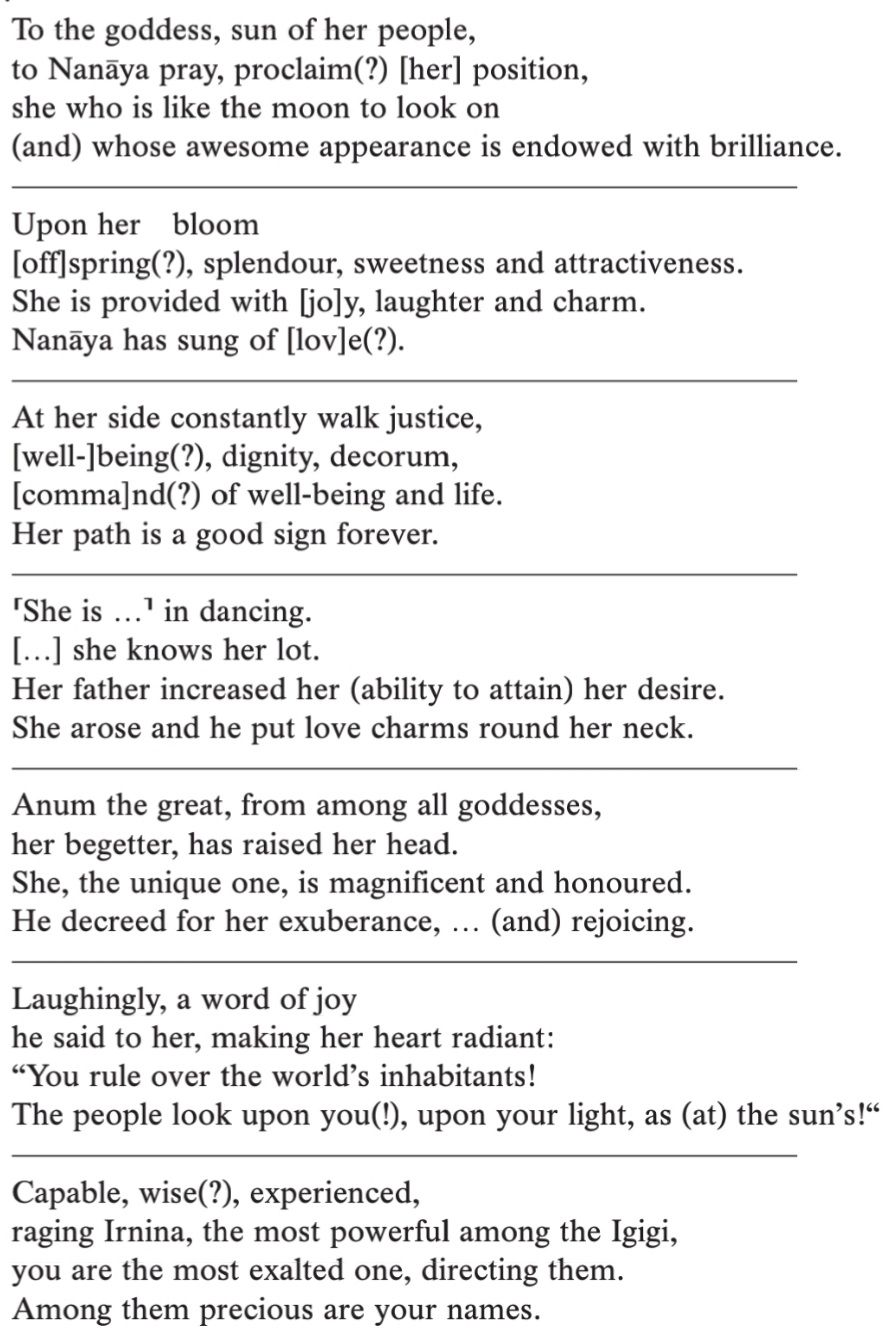
This modern rendition of Sodgian Nana shows the Indian influence.
Hindu gods are generally depicted with multiple arms to visually represent their supreme powers and superiority over humankind.
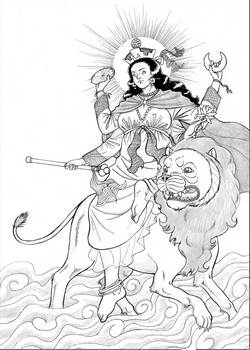
One of the later Vedas has 9 Rishis, the earlier 7 or 6, there is a story somewhat similar to the Orion Pleiades myth that is interesting because it involves Ursa Major
and joins the two, but without the gender confusion of the Mesopotamian Sebittu.
According to the epic Mahabharata, the stars of the Big Dipper were the seven sages called Rishis. These seven sages are said to be those who made the Sun rise and shine. They were happily married to seven sisters named Krttika. They originally all lived together in the northern sky.
But one day, the god of fire, Agni, emerged from the flames of an offering performed by the seven Rishis and fell in love with the seven Krttika. Trying to forget his hopeless love for the Krttika, Agni wandered in the forest where he met Svaha. To conquer Agni’s love, Svaha disguised herself as six of the seven Krttika. Svaha could mimic only six of the Krttika because the seventh sister Arundhati was too devoted to her husband to be imitated.
After a while, Svaha gave birth to a child that she named Skanda. With his birth, rumors began to spread that six of the Rishis’ wives were his mother. Six of the Rishis divorced their wives. Arundhati was the only one that remained with her husband as the star Alcor. The other six Krttika went away to become the Pleiades.
vibhanshu.wordpress.com...

There's a major issue with Aya as the consort of the Sun and Tashmetu/Nanaya as the consort of Nabu/Mercury, which i think derives from Tashmetu a relative late comer relating to intelligence/strong mind/wisdom, that became the Semitic basis of the sacred marriage and which obviously more relates to Minerva or the Cabbalistic concept of the Shekinah, in fact Nanaya would be stupid if she chose Nabu over Utu.
That would be then the difference between the sacred marriage involving a Priest King or a Sun-King, the bride would just end up marrying some pretentious Rabbi, or the bride would be refered to in terms of some weird abstract concept such as the Church or the New Jerusalem, so the old version was better which gave birth to truth and justice and dreams, through the union with the Sun.
Action Girl: In one of the hymns to Utu/Shamash, she was described as a "youthful leader of battle".
Green Thumb: The Chaldeans believed that Sherida/Aya's mystical union, or sacred marriage, with the sun god caused all vegetation to grow and flourish.
Hot Goddess: She was envisioned as an attractive young girl and one of her epiteths was "mistress adorned with voluptuousness".
Light 'em Up: Sherida/Aya was the goddess of light, and was particularly associated with the sunlight at dawn.
Light Is Good: Sherida/Aya was viewed as a giver and sustainer of light and life. Her light was associated with making the earth fertile, shining on the sea, and giving hope to everyone. She was invoked at all beginnings, when a potent surge of energy was needed to bring the renewing light of dawn.
Mesopotamian Mythology
The parentage of Sherida/Aya which isn't sourced is likely the given for Nanaya, daughter of Anu and Urash, that aspect of Earth which in union with the Sun produces life, Mercury very much an inadequate suitor for that role, and it's natural then in terms of Astral associations Aya could represent the aura of Earth and even to some extent have the primary role in the seven because all the planets were understood as born from Urash, this inevitably ends up with Nanaya in charge of seven Demons!
[...she grasps in her hand] the naked sword, [the emblem of Nergal], and the pointed axe, appropriate to the [Pleiades]. Right and left, battle is set in lines. She is the foremost of the gods, whose play is combat, she who leads the coalition of the seven demons.
I think it would be the influence the stars were under in terms of the greater context.
No not the Rabbi!! Lucky she hates them.
Like those trope descriptions, bringing the Gods into modern terms and popular culture is sign of a rebirth of sorts... definately the hot Goddess 😏
Utu, your heart may turn good (again), your liver may turn favourable, your bright countenance, your rightful judgement to the place of Šerida, your beloved (?) spouse. Šerida, your beloved (?) spouse with sweet words may she welcome you … To the couch, your (good) piece of furniture, may she (?) invite you

Typical the Sethian would try and appropriate her, can't keep their hands to themselves those creatures, which is made obvious by globohomo, but the roots go right back...
And Saul had a concubine, whose name was Rizpah, the daughter of Aiah: and Ishbosheth said to Abner, Wherefore hast thou gone in unto my father's concubine?
Anyway with their inevitable deterioration over time their conception of the feminine has become Zombie Shekinah "corpse bride" and no matter what they cut off, it's still a man.
Serida/Aya was one of the oldest Mesopotamian Goddesses and I'd guess she came via the ruling class from the proto Indo-European Goddess of the dawn h2éwsōs.
The reconstructed Proto-Indo-European name of the dawn, *h2éwsōs, derives the verbal root *h2(e)wes- ('to shine, glow red; a flame') extended by the suffix -ós-. The same root also underlies the word for 'gold', *h2ews-om (lit. 'glow')
So interesting all the syncretism, the way the peoples of the ages imagine, combine and reimagine the Divine, which is actually constant and it's only the human perception which changes, some aligning with it, others not so much, and what we have today as mainstream, not at all.
I'd say an accurate and extensive archetypical framework is vital for the functioning of a stable, moral, and just society. Divine law is natural law and hence the need for the connection, sacred Kingship an extension of this principle, and the Lady a living example. Spiritually fulfilled, humanity is capable of greatness.
A possible mythological descendant of the Indo-European dawn goddess may be Aphrodite, the Greek goddess of love and lust. Scholars posit similarities based on her connection with a sky deity as her father (Zeus or Uranus) and her association with red and gold colours. In the Iliad, Aphrodite is hurt by a mortal and seeks solace in her mother's (Dione) bosom. Dione is seen as a female counterpart to Zeus and is thought to etymologically derive from Proto-Indo-European root *Dyeus
I like the Seven Endless of popular culture from the Sandman series, Dream-Desire-Destiny-Delerium-Despair-Destruction-Death, but the association of the children of Uta and Aya with truth and justice, qualities from Utu, and the light in the darkness and dream in terms of Sisig and Mamu is really intriguing, because the issue is that most belief systems are a dream like condition that best avoids truth, the difference between Objective reality and Subjective truths, everyone thinks they're right and that they're the good guys or at least justified for whatever reason, when you try to point out that maybe they're not they hate you for trying to ruin their dream/idea of self/ego-Death.
There was a side story in Sandman about a Serial Killers convention, they had an entirely positive image of themselves as trend-setters at the cutting edge of reality, exceptional individuals, that dream was taken from them by Dream leaving them broken and anxious of their future, so there Dream conflicted with truth.

Serial killers aside if you are going to bring ruinous Destruction to the Dream of mankind i think it good if a better one is made available which would more closely relate to the truth and not lead to Delerium and Despair and that can accomodate Desire within reason trending toward a sound Destiny, if that option is rejected Death is inevitable.

Technically the Seven Endless might also be considered Eight because Delerium was formerly Delight.
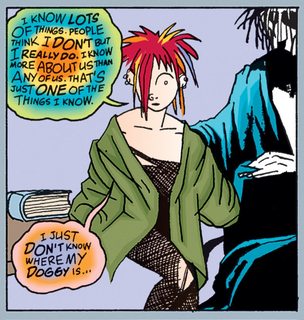
Most of us are sleeping...
The crazy clown dream really does need to be replaced with something better, the human dreams become a nightmare, these days more are waking up to that fact, but most consider that redpilled and don't take it any further. Not thinking their ideology is basically the same as before, part of the failing system besides that one changed fact, still subscribing to the belief that their part of said system is the good bit.
It's all bad, all the institutions, popular political parties, mainstream, talking heads and famous YouTube parrots, if it's making millions and in a position of power or influence it's Cabal and corrupt, or useful idiots unknowingly serving that cause, and they've all gotta go.
Rigid incorrect beliefs are the most insidious form, they preclude change, for example "nobodies perfect", isn't that just an admission of guilt and apathy? Doesn't imperfection posit the possibility of perfection. Perfection is the only thing that doesn't need to change and we'd know it if we had it. If we don't find it, because of course it's that most rare Divine flower, at least we tried and never gave up.
Does your belief stand up to logic? Our own subconscious knows the truth, when we start to find it there, we'll begin to recognise it outside, that uncomfortable feeling and guilty conscience is how it communicates, and when you know, you know, no faith required. Anything that challenges us to the point we can't reply logically, shutting down in anger or fear, should set off alarm bells, it's the blank spots we can't see that get us, and therein lie the answers most are to weak to find.
That Sandman series looks cool, you has all the cool stuffs, have to check it out... poor Delerium, hope she finds her way to a better place, returns to Delight.
-
Mexico Plans Alert App For Migrants Facing Arrest In US
Mainstream News: 1 hours ago -
Why Such An Uproar Over Non-US Citizens With H1-B Work Visas.
Social Issues and Civil Unrest: 5 hours ago -
Christmas Car Near Detroit…
Automotive Discussion: 7 hours ago -
Assetto Corsa EVO - a New Chapter in Simracing starts January 16th
Video Games: 10 hours ago
-
Why Such An Uproar Over Non-US Citizens With H1-B Work Visas.
Social Issues and Civil Unrest: 5 hours ago, 8 flags -
The Phenomenon documentary by James Fox
Aliens and UFOs: 13 hours ago, 7 flags -
Christmas Car Near Detroit…
Automotive Discussion: 7 hours ago, 5 flags -
The Looking Glass - Episode 3: The Path of Least Resistance
Short Stories: 17 hours ago, 3 flags -
Mexico Plans Alert App For Migrants Facing Arrest In US
Mainstream News: 1 hours ago, 3 flags -
New UK Petition - Close the borders! Suspend ALL immigration for 5 years!
Regional Politics: 14 hours ago, 2 flags -
Assetto Corsa EVO - a New Chapter in Simracing starts January 16th
Video Games: 10 hours ago, 2 flags
-
Why Such An Uproar Over Non-US Citizens With H1-B Work Visas.
Social Issues and Civil Unrest • 28 • : watchitburn -
Waterloo in 20mm world's largest diorama (on view at NAM Chelsea Oct 20 & 21) new pics added 10 -16
Member Art • 52 • : Asktheanimals -
The Phenomenon documentary by James Fox
Aliens and UFOs • 4 • : bscotti -
Christmas Car Near Detroit…
Automotive Discussion • 6 • : JJproductions -
Plane Crash Today --Azerbaijanian E190 passenger jet
Mainstream News • 67 • : andy06shake -
Mexico Plans Alert App For Migrants Facing Arrest In US
Mainstream News • 3 • : Flyingclaydisk -
Credit card debt
Relationships • 6 • : confuzedcitizen -
Spiritual Solstice
Short Stories • 18 • : argentus -
Kurakhove officially falls. Russia takes control of major logistics hub city in the southeast.
World War Three • 14 • : hangedman13 -
Parker Solar Probe is about to Kiss the Sun
Space Exploration • 12 • : Flyingclaydisk

